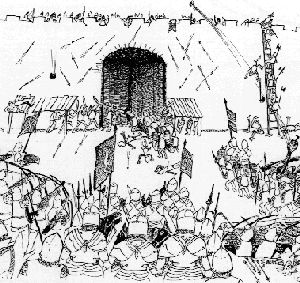Meet the Middle Ages
BackThe Engelbrekt rebellion

King Erik wanted to be a powerful Union King, but he was not as talented a politician and diplomat as Queen Margareta. He wanted loyal men at his castles, and appointed Danish noblemen as his bailiffs. The Swedish aristocracy protested against this. The men of the Church were also displeased; they did not want the Danish bishops appointed by the King.
There was also an on-going conflict between Denmark, Holstein and the Hanseatic League. The League stopped selling salt and other goods to Sweden and refused to buy Swedish iron and copper. In order to finance the conflict, King Erik raised the taxes. Many Swedes and Norwegians suffered and protested.
At this time, there was a miner in Bergslagen called Engelbrekt Engelbrektsson. Engelbrekt, together with men from the province of Dalarna, was exhausted by the high taxes and the shortage of foreign merchandise. Engelbrekt was chosen to lead a rebellion. The motto of this rebellion was "Burn the castles!". At midsummer in 1434, the Castle of Borganäs with its despised bailiff Jösse Eriksson, was burned to the ground. Rapidly the uprising spread to the south. The Castles of Faxehus, Köping, Piksborg and Helgesrum, were attacked and burned down.
Engelbrekt made the Swedish Council "withdraw the allegiance to the King". Erik realised that his position was threatened. He tried to make peace with the Hanseatic league and the peasants were promised lower taxes. At a parliamentary session in Arboga in 1435, Engelbrekt was elected captain of the realm, whilst Erik remained on the Swedish throne.
At Whitsuntide in 1436, Engelbrekt was attacked and murdered. The murder led to new peasant uprisings. In 1439, King Erik of Pommern was dethroned and the rebels had won.